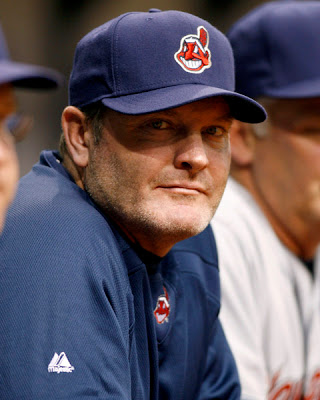tedginnjr
NBA Starter
- Joined
- Jul 21, 2006
- Messages
- 3,407
- Reaction score
- 4,117
- Points
- 113
BP Daily: No longer on the warpath
Bullpen failures and player development problems have doomed the Indians
By Jay Jaffe
Baseball Prospectus
Two seasons after they fell one win shy of a pennant, the Cleveland Indians are flying the white flag. For the second straight summer, they've traded the reigning AL Cy Young Award winner in exchange for prospects, this after a squad projected to win its division fell flat on its face out of the gate. Cliff Lee's trade to the Phillies was just one of five forward-looking deals general manager Mark Shapiro made to dismantle this lost Tribe, with Mark DeRosa, Victor Martinez, Ryan Garko and Rafael Betancourt leaving town as well.
It's tough to quantify disappointment, at least beyond 61 years without a world championship. Although we've already given the Indians their equivalent of a Golden Raspberry on the PECOTA front, that system's relatively brief existence (since 2003) requires turning to a different forecasting method for a deeper historical perspective.
Years ago, Baseball Prospectus co-founder Rany Jazayerli demonstrated that a team's recent history -- its three previous years of performance, to be exact -- is useful in predicting its winning percentage. Along the way, he confirmed a 20-year-old Bill James finding called the whirlpool principle, the strong tendency of teams to be drawn toward .500, a concept that's more commonly known as regression to the mean. Based upon a multivariate regression analysis of 70 years of historical data, the formula Jazayerli emerged with was Y = .1557 + (.4517 x X1) + (.1401 x X2) + (.0968 x X3), where X1, X2, and X3 are the team's winning percentages from one, two and three years ago, respectively.
Whereas PECOTA uses performance and playing-time projections, Jazayerli's formula is blind to a team's personnel, skills and deployment, but it's available and effective over a much longer historical range. Via this formula, the Indians were projected to post a .511 winning percentage this season after showings of .481, .593 and .500 the past three years. As such, they rank as this year's second-most-disappointing team, even given their modest projections:
What a disappointment
The 15 most disappointing teams in MLB, via BP co-founder Rany Jazayerli's theory.
Team Projected Actual +/-
Washington Nationals .427 .314 -.113
Cleveland Indians .511 .419 -.092
Arizona Diamondbacks .508 .438 -.069
Kansas City Royals .462 .394 -.069
Oakland Athletics .487 .423 -.064
New York Mets .538 .481 -.057
San Diego Padres .460 .406 -.055
Cincinnati Reds .472 .433 -.039
Toronto Blue Jays .519 .486 -.034
Minnesota Twins .525 .495 -.030
Milwaukee Brewers .523 .495 -.028
Baltimore Orioles .448 .423 -.025
Houston Astros .509 .495 -.014
Chicago White Sox .518 .509 -.009
Pittsburgh Pirates .441 .433 -.009
That 92-point shortfall would rank as the 22nd-highest of the poststrike era (1996 onward), while the Nationals' 113-point gap is one point out of 10th place. The Tribe figure to rise in those historical rankings given their recent trades; Clay Davenport of BP estimates that their PECOTA-projected record for the remainder of the year dropped 50 points during the past 10 days, even while the team went 7-3.
What has gone wrong in Cleveland? PECOTA's division-winning projection called for a meager 86 wins (around three more than the above method suggests) and a 38 percent chance of making the postseason, casting the Indians as weak favorites over the Tigers. Despite injuries to Travis Hafner and Grady Sizemore, the offense essentially has lived up to expectations: Projected to rank fourth in the American League in scoring, it actually ranks fifth. The pitching, however, ranks dead last instead of the projected seventh.
The responsibility for that showing rests with both the rotation (13th in SNLVAR in the AL) and the bullpen (14th in WXRL). Blame Shapiro for assembling the rotation, which has put up a 5.95 ERA beyond Lee. Although the GM's acquisition of Anthony Reyes last year was a worthwhile gambit that went sour thanks to elbow problems that culminated in Tommy John surgery, his signing of Carl Pavano has brought plenty of bad (five disaster starts, or those with more runs than innings pitched) to go with the good (10 quality starts), with a 5.37 ERA and 1.4 homers per nine innings. Manager Eric Wedge and his coaching staff own a share of the blame for failing to straighten out Fausto Carmona; hoping the sinkerballer would regain his stellar 2007 form after mechanical and injury woes ruined 2008, they suffered a 7.42 ERA in 12 gruesome starts before farming him out in June. The rest of the rotation fillers -- Aaron Laffey, Jeremy Sowers, Zach Jackson, David Huff and Scott Lewis -- apparently arrived from a big-box store where hittable lefties are sold by the gross; that quintet has given the Tribe 36 starts with a 5.73 ERA and just 4.7 strikeouts per nine.
The bullpen has been worse, a major reason the team is an AL-high 7.7 wins behind its projected third-order record (its Pythagorean record after adjusting for scoring environment, run elements and quality of opposition). Poor early-season performances by Kerry Wood, Betancourt (since traded to Colorado), Rafael Perez (since demoted) and Jensen Lewis (recalled this past weekend after a five-week demotion) dug the team an early hole; the Indians already were 4.7 games behind their third-order projection by mid-May. That was around the time the buzzards started circling Wedge, who presided over an uncannily similar debacle last year, when the relievers he rode hard late in 2007 spit the bit. Wedge has presided over three slow-starting teams in the past four years. Although his overall record stands at 540-537, just two of his seven teams have finished better than .500, and they've fallen a cumulative 29 games shy of their Pythagorean projections.
Shapiro will have to answer for his pledge to keep his skipper in place -- and, ultimately, for the drying up of the team's talent pipeline amid years of unimpressive drafts. From 1997 through 2008, the Indians organization produced more major league talent than any other AL Central team, according to the value production standings work that Steve Treder presented at the most recent SABR convention. Alas, an increasing proportion of that value, from Manny Ramirez and CC Sabathia down through Jeremy Guthrie, was delivered for other teams. As ESPN's Jerry Crasnick pointed out recently, Guthrie has been the most successful of the 19 first-round or supplemental picks on Shapiro's watch, but all of that success has been with the Orioles. Among those on the Indians' major league roster, top 2004 pick Sowers and top 2006 pick Huff are among the glut of low-upside left-handers, while top 2005 pick Trevor Crowe looks like a card-carrying member of the Future Fourth Outfielders of America.
Ultimately, a failure to produce top talent from within is the bane of a midmarket franchise's existence, for it magnifies a team's more expensive mishaps, such as the injuries sapping the value of Hafner's four-year, $57 million deal and Jake Westbrook's three-year, $33 million pact. This season is bitter enough given the dashed expectations for the Indians, and unless the prospects they've acquired in recent weeks can develop to cover for the system's recent mediocrity, the team will only keep disappointing.
Jay Jaffe is an author of Baseball Prospectus.
http://insider.espn.go.com/mlb/insider/news/story?id=4376040&addata=2009_insdr_mod_mlb_xxx_xxx



